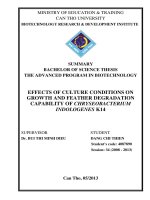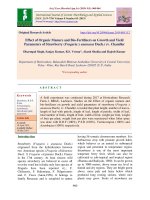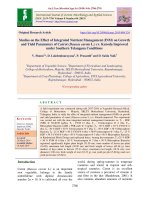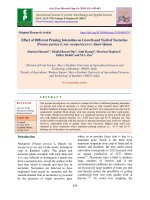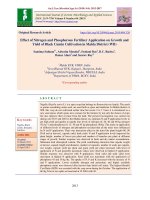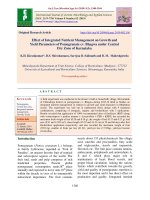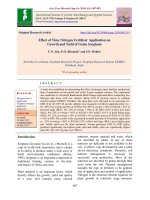Effect of water deficit conditions on growth and yield of four maize varieties
Bạn đang xem bản rút gọn của tài liệu. Xem và tải ngay bản đầy đủ của tài liệu tại đây (2.34 MB, 92 trang )
VIETNAM NATIONAL UNIVERSITY OF AGRICULTURE
FACULTY OF AGRONOMY
---------------------------------------------------
UNDERGRADUATE THESIS
TITLE:
Effect of water deficit conditions on Growth
and Yield of four maize varieties
Instructor:
PhD. TRAN THI THIEM
Department:
CULTIVATION SCIENCE
Student
NGUYEN HUU LAM
Class:
K61KHCTT
Course:
2016 - 2021
Major:
CROP SCIENCE
HANOI - 2020
DECLARATION
I hereby declare that this paper is my own work. All results and data in this thesis
are absolutely honest and have not been used in a different thesis. All sources used
in this paper were cited in references.
Hanoi, February 28th ,2021
Student
Nguyen Huu Lam
i
ACKNOWLEGEMENTS
To complete this thesis, I am deeply indebted to many people for their
advice, instruction and support.
First and foremost, I would like to send my gratitude to my instructor, Dr.
Tran Thi Thiem, Dept. of Cultivation Science, Faculty of Agronomy, Vietnam
National University of Agriculture, for his enthusiastic support, helpful advice
and considerable encouragement in the completion of my thesis.
I would also like to give my gratitude to my teachers who gave me the
necessary knowledge and skills during my time here. Especially I would also like
to give my gratitude to all of my teachers in faculty of Agronomy.
In addition, I would like to acknowledge my family, who always stood by
me, for their in conditional love and support, both financially and emotionally
throughout my work.
Save the best for last, I want to express my thanks to my friends in Vietnam
National University of Agriculture for their friendship and support.
Hanoi, February 12st, 2021
Student
Nguyen Huu Lam
ii
CONTENTS
DECLARATION ................................................................................................... i
ACKNOWLEGEMENTS .................................................................................... ii
CONTENTS ........................................................................................................ iii
LIST OF TABLES ............................................................................................... vi
LIST OF FIGURES ............................................................................................ vii
LIST OF ABBREVIATIONS ........................................................................... viii
ABSTRACT ........................................................................................................ ix
Chapter I INTRODUCTION ................................................................................ 1
1.1. Introduction ................................................................................................... 1
1.2. Objectives and requirements ......................................................................... 2
1.2.1. Objectives ................................................................................................... 2
1.2.2. Requirements .............................................................................................. 3
Chapter II LITERATURE REVIEW .................................................................... 4
2.1. Situation of maize production on the world and in Vietnam ......................... 4
2.1.1. Situation of maize production in the world ................................................ 4
2.1.2. Maize production in Vietnam ..................................................................... 6
2.2. Drought and the influence of drought............................................................ 8
2.2.1. Drought definition ...................................................................................... 8
2.2.3. Influence of drought ................................................................................... 9
2.3. Effect of drought on maize .......................................................................... 11
2.3.1. Effect on growth and development ........................................................... 11
2.4. Recent studies and researches on drought in maize in the world and in
Vietnam .............................................................................................................. 14
2.4.1. Recent studies and researches of drought in maize in the world .............. 14
2.4.2. Recent studies and researches of drought in maize in Vietnam ............... 18
Chapter III MATERIAL AND METHOD ......................................................... 21
3.1. Objects, materials of the research ................................................................ 21
3.1.1. Objects and materials................................................................................ 21
iii
3.2. Location and time ........................................................................................ 21
3.3. Research contents ........................................................................................ 22
3.4. Methods ....................................................................................................... 22
3.4.1. Plant materials and Growing condition .................................................... 22
3.4.2. Drought treatment ..................................................................................... 23
3.4.3. Measurement of growth indices ............................................................... 23
3.4.4. Cultivation methods .................................................................................. 24
3.4.5. Statistical analysis..................................................................................... 25
Chapter IV RESULTS AND DISSCUSSION .................................................... 26
4.1. Effect of water deficit conditions on growth traits of four maize varieties
grown in the vinyl house .................................................................................... 26
4.1.1. Effect of water deficit conditions on plant height of four maize varieties
grown in the vinyl house .................................................................................... 26
4.1.2. Effect of water deficit conditions on the increasing in number of leaves of
four maize varieties grown in the vinyl house .................................................... 31
4.2. Effect of water deficit conditions on physiological traits of four maize
varieties grown in the vinyl house. ..................................................................... 34
4.2.1. Effect of water deficit conditions SPAD value of four maize varieties
grown in the vinyl house. ................................................................................... 34
4.2.1.1. Effect of water deficit conditions on SPAD value of four maize varieties
in tasseling stage ................................................................................................. 35
4.2.1.2. Effect of water deficit conditions on SPAD value of four maize varieties
in silking stage .................................................................................................... 36
4.2.3. Effect of water deficit conditions on shoot dry matter of four maize
varieties grown in the vinyl house. ..................................................................... 41
4.2.4. Interacting effect of water deficit conditions on physiological traits of four
maize varieties grown in the vinyl house. .......................................................... 43
4.2.5. Effect of water deficit conditions on root traits of four maize varieties
grown in the vinyl house. ................................................................................... 45
iv
4.3. Effect of water deficit conditions on yield of four maize varieties grown in
the vinyl house. ................................................................................................... 51
4.3.1. Effect of water deficit conditions on the number of kernels per ear, 1000
kernels weight and grain yields of four maize varieties grown in the vinyl house.
............................................................................................................................ 51
CHAPTER V CONCLUSIONS AND SUGGESTIONS ................................... 55
5.1. Conclusions ................................................................................................. 55
5.2. Suggestions .................................................................................................. 57
REFERENCES ................................................................................................... 57
SOME PICTURE IN EXPERIMENT ................................................................ 62
v
LIST OF TABLES
Table 2. 1. Maize production in the world in recent years ................................. 11
Table 2. 2. Maize production in Vietnam in recent years................................... 12
Table 4. 1. Effect of water deficit conditions on plant height of four maize
varieties............................................................................................................... 26
Table 4. 2. Interacting effect of water deficit conditions on plant height of four
maize varieties .................................................................................................... 29
Table 4. 3. Effect of water deficit conditions on leaves number of four maize
varieties............................................................................................................... 31
Table 4. 4. Interacting effect of water deficit conditions on the increasing of
leaves number of four maize varieties ................................................................ 33
Table 4. 5. Interacting effect of water deficit conditions on physiological traits
of four maize varieties grown in the vinyl house. .............................................. 43
Table 4. 6. Effect of soil water content on number of primary roots, primary root
length and root dry weight of four maize varieties ............................................. 45
Table 4. 7. Interacting effect of soil water content on number of primary roots,
root length and root dry weight of four maize varieties ..................................... 48
Table 4. 8. Effect of soil water content on number of kernels per ear, 1000
kernels weight and grain yields of four maize varieties ..................................... 51
Table 4. 9. Interacting effect of soil water content on number of kernels per ear,
1000 kernels weight and grain yields of four maize varieties ............................ 53
vi
LIST OF FIGURES
Figure 4. 1. Effect of water deficit conditions on SPAD value of four maize
varieties at tasseling stage................................................................................... 35
Figure 4. 2. Effect of varieties on SPAD value under four water deficit
conditions in 15 leave stage ................................................................................ 36
Figure 4. 3. Effect of water deficit conditions on SPAD value of four maize
varieties at silking stage ...................................................................................... 37
Figure 4. 4. Effect of varieties on SPAD value under four water deficit
conditions in silking stage .................................................................................. 38
Figure 4. 5. Effect of water deficit conditions on leave area of four maize
varieties in sliking stage ..................................................................................... 39
Figure 4. 6. Effect of varieties on leave area under four water deficit conditions
............................................................................................................................ 40
Figure 4. 7. Effect of water deficit conditions on shoot dry matter of four maize
varieties............................................................................................................... 41
Figure 4. 8. Effect of varieties on shoot dry matter under four water deficit
conditions............................................................................................................ 42
vii
LIST OF ABBREVIATIONS
ABBREVIATION
MEANING
%
Percentage
CV
Coefficient of variation
Et al.
et alii
FAO
Food and Agriculture Organization
FAOSTAT
The Food and Agriculture Organization Corporate
Statistical Database
ha
Hectare
LSD
Least significant difference
SPAD
SPAD
WD
Water deficit condition
W1000
Weight of 1000 seeds
SWC
Soil water contents
viii
ABSTRACT
In Vietnam, maize is an important crop used as a raw material for
industrial production. At present, many maize growing areas are under effects of
drought stress, which adversely constrain the maize production. This study aimed
to determine the individual and combined effects of water deficit conditions on
the growth and yield of four maize varieties.
The pot experiment was carried from August 2020 to March 2021 under
vinyl-house conditions at Faculty of Agronomy, Vietnam National University of
Agriculture, Trau Quy commune, Gia Lam district, Hanoi. Experimental design
is randomized complete block design with three replications. Four treatments
included 30%, 25%, 20% and 15% of soil water content and four selected maize
varieties CP111, LCH9, NK7329 and NK4300. The treatments were applied from
the stage of 7-9 leaves stage to harvested stage. The pots were weight daily in
order to maintain soil water content levels
The results showed that under lower water deficit conditions, maize growth
was inhibited with reductions in plant height, total leaf number, leaf area, SPAD,
total dry weights and yield traits as number of seeds, weight of 1000 seeds.
Nevertheless, root traits were recorded to be significantly increased, with the
highest value was found in 15% soil water content. Additionally, LCH9 and
NK7328 is the two varieties having a better adaptation under water deficit
condition in terms of growth, physiological traits and yield traits
ix
Chapter I
INTRODUCTION
1.1. Introduction
Maize (Zea mays L.) is one of the most important cereal crops all over the
world which is cultivated for food, feed, and industrial materials. Maize has been
cultivated by almost all countries and territories around the world and has been
continuously expanding in production. In 2014, according to data of the Food and
Agriculture Organization of the United Nations (FAO), worldwide maize
production reached a record in terms of area, productivity as well as output.
Specifically: The area of maize in the world is 191.27 million hectares, total
production reaches 1052.6 million tons. Meanwhile, this area in 2019 is 197.2
million hectares, the average yield is 6.41 tons /ha and the total yield will reach
1148.48 million tons. It is forecasted that from 2011 to 2050, demanding for maize
in developing countries will double, and by 2025 it will become the crop with the
largest production demand globally and in developing countries development
(CIMMYT, 2011).
Although maize yields have increased significantly in modern times, its
production in all stages of plant growth, especially flowering and grain filling, is
threatened globally by drought (Lobell et al. 2014). Droughts are major natural
disasters that can affect large areas. Severe droughts can have substantial effects
on economic, agricultural, ecological, and environmental activities. Across the
world, drought is one of the most serious environmental stresses affecting plant
growth and development and, consequently, the yields and productivity of crops.
According to General Statistics Office of Vietnam, in 2019, total area of maize
was recorded about 1,2 billion ha, 4,32 tons/ha in productivity and 4.431,8 ton
total yield. While the current domestic demand for maize is over 5 million tons/ha
per year including food processing and livestock, the total maize production is
still not enough for domestic demand and importing more than half a million tons
each year. This is a favorable condition for the development of maize production
to expand. During the last few decades, major drought events have been recorded
1
and are projected to intensify in most parts of Asia and beyond, which could make
farming exceedingly challenging in some countries. According to (Daryanto,
2016) the average decrease in maize production due to drought stress is about
40% globally. Another evidence is that during the period 2000–2007,
approximately 3% of the global cereal production was lost to extreme drought
disasters (Lest et al. 2016). Currently, the urgency for research in droughttolerant maize for each ecological region and each country becomes more and
more urgent in many Southeast Asean countries. On the one hand, there is an
increasing demand for maize in eastern and southeast Asia. On the other hand, the
weather fluctuates greatly, leading to more and more droughts.
In Vietnam, maize is the second food crop after paddy rice, commonly
grown in many ecological regions in different seasons. Especially with extreme
climatic conditions such as drought, cold and hot weather ... maize which is well
known by it’s drought tolerance traits is considered the main crop in agricultural
production. Drought is the main reason for the decrease, yield and quality of maize
in Vietnam. It is estimated that the output of maize which is damaged by drought
in Vietnam is up to 30%. In recent years, the area of drought is increase
significantly, about 70 - 80% and many regions can not harvest due to low yield
(Phan Xuan Hao, 2005). Adequate information on latter vegetative stage and early
reproductive stage of maize to drought and salinity is not available.
In order to manage drought properly, we need to understand the impact of
water content in the soil on growth and physiology of maize from which to base
on appropriate measures to impact, especially the period after seedling stage
Rely on the facts and the needs above, we do the research on: “Effect of
water deficit conditions on growth and yield of four maize varieties grown in
the vinyl house”
1.2. Objectives and requirements
1.2.1. Objectives
This study was conducted to examine if the growth and development of four
maize varieties would be affected by the different water deficit conditions. Based
2
on the above evaluation, the maize variety adapted to drought conditions would be
selected
1.2.2. Requirements
- Evaluating effect of water deficit conditions on growth traits of four maize
varieties grown in the vinyl house
- Evaluating effect of water deficit conditions on physiological traits of four
maize varieties grown in the vinyl house.
- Evaluating effect of water deficit conditions on yield of four maize
varieties grown in the vinyl house.
3
Chapter II
LITERATURE REVIEW
2.1. Situation of maize production on the world and in Vietnam
2.1.1. Situation of maize production in the world
The maize production in the world has increased continuously since the
early twentieth century up to now, especially in the last 10 years, maize is one of
the crops with the highest yield growth rate among major food crops. In 1961, the
worldwide maize acreage was 105.6 million hectares with an average yield of 1.9
tons per hectare and a total production of 205 million tons. By 2000, the area of
maize cultivation increased by 1.3 times compared to that of 1961 and reached
137.0 million hectares, the average yield of 4.3 tons / hectare reached a total
production of 592.5 million tons. The area of maize harvested in the world has
been gradually expanded over the years, leading to an increase in productivity and
total output. By 2011, the world maize area was 172.1 million hectares (an
increase of 1.25 times compared to 2000), the average yield was 5.2 tons / ha,
reaching a total output of 888 million tons. The highest maize production was
recorded in the lastest year – 2019 with over 197 million hectares in area
harvested, the yield reached 6,4 tons/ha and the production quantity is 1148,5
tonnes.
Table 2. 1. Maize production in the world in recent years
Area harvested
Yield
Production
(Million of hectares)
(Tonnes per hectares)
(Million of tonnes)
1961
105,6
1,9
205
2000
137,0
4,3
592,5
2005
149,0
4,8
713,7
2011
172,1
5,2
888,0
2018
196,8
6,3
1124,5
Year
4
2019
197,2
6,4
1148,5
(FAOSTAT, 2019)
Among the maize growing countries, the US always occupies the leading
position in terms of maize production, and is also one of the countries with the
highest yield and area harvested in term of maize, in 2019, the area was 32.9
million hectares, productivity an average of 11,6 tons / ha and the yield 307.4
million tons (FAOSTAT, 2019). China ranks first in terms of maize acreage in
the world and has an average maize yield higher than the world average. In 2019,
the maize acreage in China was 41,3 million hectares with yield of 6.96 tons / ha
and production is 260,9 million tons. According to the forecasts of the US
Department of Agriculture (USDA), the global maize harvest for 2019-2020 will
show a slight decrease compared to the previous year: in fact, the estimates speak
of 1,108 million tonnes, as opposed to 1,124 million tonnes for 2018-2019.
The ranking of the top maize consumers is led by the 2 main producers: In
fact, the United States and China are the countries where this grain is most widely
utilised. In China’s case, the domestic consumption actually exceeds the national
production.
The European Union plays an important role in maize consumption,
followed by several major producers, including Brazil, Mexico, India and Canada.
A number of the major maize importers are also among the major consumers:
Egypt, Japan and Vietnam.
5
Figure 2. 1. Maize production according to countries
(USDA, 2019)
2.1.2. Maize production in Vietnam
In Vietnam, maize has long been the second largest annual crop in terms of
acreage. Maize is one of several local crops, including cassava, broken rice, and
rice bran, that is used to supply the feed industry. However, maize is planted only
in mountainous regions with poor soil fertility and other regions lacking adequate
water supplies. Since maize is primarily grown in unfavorable conditions,
Vietnam’s corn yields are low. In addition, maize yields are also affected by crop
losses due to pests and disease.
In 1961, the total harvested area of maize in Vietnam was only 260.2
thousand hectares, the production reached 292.2 thousand tons. Since 2000, the
maize production in Vietnam has seen remarkable growth. In 2000, the cultivated
area was 730.2 thousand hectares, with an output of 2005.9 thousand tons; in
2005, the area was 1,050.6 thousand hectares, the output was 3,787.1 thousand
tons; By 2010, the area is 1,126.4 thousand hectares with the production of
4,606.8 thousand tons. Thus, in the 2000-2010 period, the maize cultivated area
increased to 396.2 thousand hectares, the output increased by 2600.9 thousand
tons. Growth in both acreage and yield led to a strong growth in maize output,
6
yield growth of 9.08% / year. By 2018 and 2019, the maize acreage nationwide
decreased slightly compared to 2010, but the average yield and output of the
country still increased.
In the new stage of agricultural development, maize plays an increasingly
important role, contributing to the rapid transformation of economic structure
towards
commodity agricultural
production, safety, sustainability and
diversification.
Table 2. 2. Maize production in Vietnam in recent years
Area harvested
Yield
Production
(Thousand hectares)
(Tones per hectares)
(Thousand tones)
1961
206,2
1,1
292,2
2000
730,2
2,7
2005,9
2005
1052,6
3,6
3787,1
2010
1126,4
4,1
4606,8
2018
1032,5
5,2
4874,0
2019
991,1
5,3
4756,2
Year
(FAOSTAT, 2019)
Argentina is the largest supplier of maize in Vietnam, accounting for nearly
71% of the country's total maize import volume and turnover.
According to statistics of the General Department of Vietnam Customs,
maize imported to Vietnam in the first eight months of 2020 increased by 10% in
volume. Argentina is the largest supplier of maize to Vietnam, accounting for
nearly 71% of the country's total corn import volume and turnover, reaching 5.04
7
million tons. Behind the main market Argentina is Brazil market with 1.08 million
tons.
2.2. Drought and the influence of drought
2.2.1. Drought definition
(Wilhite, 2002) Drought is an insidious natural hazard that is a normal part
of the climate of virtually all regions. It should not be viewed as merely a physical
phenomenon. Rather, drought is the result of an interplay between a natural event
and the demand placed on water supply by human-use systems. Drought should
be considered relative to some long-term average condition of balance between
precipitation and evapotranspiration.
Drought has been defined variously, but a general definition refers to
drought as an extended period (a season, a year, or several years) of deficient
precipitation compared with the statistical multi-year average for a region that
results in water shortage for some activity, group, or environmental sector
(National Drought Mitigation Center, University of Nebraska, 2018).
Drought is considered the most destructive condition influencing the growth of
crop plants consequently leading to decreased yield (Lambers et al., 2008)
Drought is a natural phenomenon that is considered a natural disaster,
because it causes moisture to evaporate on the surface of leaves and soil, disrupt
the water balance in plants, seriously affect the growth and development of plants
(Nguyen Trong Hieu, 2006; Tran Duc Hanh, Doan Van Diem, 2006).
According to the point of view that the maize plant is drought-sensitive:
about 4 weeks during the time when the tassel appearance, when the rainfall below
100mm, the area is considered the unsuitable area, above 200mm is considered
the suitable area and within 100 -200mm is considered a water deficit area for
maize production (Chapman and Barreto, 1996).
2.2.2. Drought classification
In researching the causes of drought, many authors believe that the lack of
regular rainwater is the main cause of drought. The issue of rainy time, the rains
time is decisive to the feature of local drought or severe drought.
8
According to Hoang Minh Tan et al. (2006) providing the concept and
classification of drought as follows:
Drought is a phenomenon that occurs when water in plant is deficit. Due to
the lack of water, the amount of water absorbed into the plant cannot compensate
for the evaporation of water passing through the parts on the ground, making the
plant water imbalance and wilt. There are three types of drought for trees:
Soil drought occurs when the amount of water reserved for plants absorbed
in the soil is depleted, so the plants do not absorb enough water and lose water
balance. Drought usually occurs in areas with very low average rainfall and lasts
for many months a year such as the central provinces, the Central Highlands in
the dry season.
Air drought occurs when the air humidity is too low, making the process of
evapotranspiration of plants too strong and can also lead to water imbalance in
the plant. Air drought usually occurs in areas with dry and hot winds such as the
southwest “Laos” wind season of the central provinces, the dry season in the
Central Highlands or sometimes the northeast monsoon also has low humidity.
Physiological drought occurs when the physiological state of the plant does
not allow the plant to absorb water even in the absence of water shortage. Because
of the roots could not get water, but the evaporation still took place, so the plant
still lost water balance. For example, when the soil is anaerobic, the roots lack
oxygen for respiration so there is not enough energy to absorb water; or when the
concentration of salt in the soil is too high, exceeds that of the root cytoplasm,
making the roots unable to absorb water; or the case where the soil temperature is
too low, physiological drought also occurs ...
If severe and prolonged, physiological drought is also harmful as soil and
air. If the drought is combined with drought, the level of damage to the tree
increases much.
2.2.3. Influence of drought
There is nearly 47% of cultivated area is drought in the world (Michon
Scott, 2018). According to the report of Guoyong Leng (2021) showed that a
9
moderate, severe, extreme and exceptional drought event (based on the
standardized precipitation evapotranspiration index) in the US would lead to a
yield loss risk of 64.3%, 69.9%, 73.6%, and 78.1%, respectively, with hotspots
identified in Central and Southeastern US. Another example was recorded by
USDA and Mosanto (2007), some countries such as the US decreased by 14.7
million tons; France decreased 1.36 million tons; Romania reduced 1.8 million
tons. According to the assessment of FAO (2007), drought is one of the biggest
challenges for crops in general and maize in particular.
Droughts affect livestock and crops, including cornerstone commodities
like corn, soybeans, and wheat. At the height of the 2012 drought, the U.S.
Department of Agriculture declared a natural disaster over 2,245 counties, 71
percent of the United States. Globally, drought struck several major breadbasket
regions simultaneously in 2012, adding to food price instability. In countries
already facing food insecurity, cost spikes can lead to social unrest, migration,
and famine.
Drought can reduce up to 65-87% crop yield depending on the type of plant,
its severity depends on the duration and intensity of drought (McLaughlin and
Boyer, 2004). Drought in agriculture is also related to the sensitivity of plants in
different stages of development (Le Quy Kha, 2005). Under normal compared
with drought conditions, drought-tolerant maize varieties can overcome 15-25%
of the yield difference, farming techniques contribute 15-25%, 50-70% of reduced
yield, the rest only can be overcome with irrigation water (Zaidi, 2000).
In Vietnam, droughts occur in different regions at different levels and
times, causing significant socio-economical losses, especially water resources and
agricultural production. Vietnam is one of the five countries in the world most
affected by climate change. According to statistics, in the period from 1960 up to
now, the number of years of drought is 40 years, accounting for 75% with
different levels of drought (winter-spring season 15 years, mid-season 12 years,
summer-autumn season 13 years). Meanwhile, flood occurred more and more
10
seriously such as the flood in early November 2020 in Central provinces.
(Ministry of Natural Resources and Environment, 2020).
Although Vietnam has abundant water resources, 62-63% of the water
sources originated from outside the territory and the dry season lasts for 6-7
months, causing serious water shortages in many regions (Ministry of Natural
Resources and Environment, 2007). According to Nguyen Trong Hieu (2007),
from 1960 to 2006, there was 34/46 years of drought (accounting for 74%),
especially in recent years, the drought is getting worse and worse. The Ministry
of Natural Resources and Environment, said that the total surface water of our
country in 2025 will be only about 96% compared with the present, the next 50
years will be lacked of water.
Depending on regions, maize is grown in seasons according to the
distribution of rainfall, but drought occurs quite often due to the erratic nature of
the rain distribution. In the past 55 years, large-scale drought in winter-spring
season accounted for 22%; The summer-autumn season accounts for 12%, of
which over 60% of the winter-spring drought and over 80% of the summerautumn term is related to El-nino, especially the winter-spring crop 1962-1963,
1976-1977, 1982-1983, 1997- 1998 and the Summer-Autumn seasons of 1963,
1977, 1983, and 1998 were the years when El-nino caused severe droughts
(Nguyen Trong Hieu and Pham Thi Thanh Huong, 2007; Tran Thuc and Le
Nguyen Thuc, 2006).
In Vietnam, about 0.3 million hectares of maize are susceptible to water
shortage during the silk appearance stage, which can damage up to 0.5 to 0.7
million tons of corn kernels (Le Quy Kha and Tran Hong Uy , 2005). It is more
serious if the drought is combined with the temperature that exceeding to 38 ° C,
the phenomenon of damaging the tassel. This phenomenon usually occurs in
Vietnam (Tran Hong Uy, 1998).
2.3. Effect of drought on maize
2.3.1. Effect on growth and development
11
Maize is a C4 plant, requires 350 - 500 liters of water in order to produce 1
kg of seeds (Ruaan, 2003). Drought stress seriously hindered the growth and
development of maize. Growth and development comprised of numerous
component parameters which are estimated by different traits like, plant height,
leaf area, structural and functional characters of root, plant biomass, plant fresh
weight, plant dry weight and stem diameter. Plant height, stem diameter, plant
biomass and leaf area are reduced under drought stress (Khan et al. 2001; Zhao et
al. 2006).
Leaf size and number of leaves are reduced in maize by drought stress.
Turgor pressure, light interception and flux assimilation are determinant of leaf
elongation (Rucker et al. 1995). Wedge shaped motor cells are present on the
upper leaf surface and these keep the leaves unfold whereas, under drought stress
turgor of leaves is reduced and leaves are curled or folded (Du Plessis 2003). Leaf
folding reduces the leaf area and resultantly light interception is reduced which
decreases the photosynthetic activity
Cell division and cell elongation are reduced under drought stress which
reduces the leaf area. Reduction in leaf area under drought stress conditions is
taken as adaptive strategy by maize plants. Leaf area index is considered as an
important parameter for maize breeding against drought stress (Hajibabaee et al.
2012)
In seedling stage, drought can affect plant density. If water deficit occurs
first and after 2 weeks of tasseling, it will reduc leaf area and photosynthesis speed
in reproduction period, decreasing ear size and decreased photosynthesis rate accelerating leaf (Banzinger et al., 2000)
Roots of maize plant becomes elongated under mild drought stress to
explore the more soil foils for more water uptake whereas, under severe drought
stress root length is reduced. Root density, volume and number of roots are
reduced under mild and severe drought stress (Nejad et al. 2010).
2.3.2 Effect on reproduction stage
12
Drought has adverse effects on maize life cycle; particularly reproductive
growth phase is most susceptible to drought stress. Translocation of
photosynthetic assimilates to the reproductive parts rather than roots for their
extensive elongation is most probable reason for more susceptibility of maize
plant during reproductive growth stage under drought stress (Setter et al. 2001;
Taiz and Zeiger 2006). Drought leads to stomata closure, reducing photosynthesis
leading to undifferentiated growth top cells, or adversely affects ear and tassel
differentiation that resulting to reduced yield.
Drought reduces the growth of leaves the most, followed by silks, stems,
and finally the seed size. Drought reducing soil coverage, reducing the area of
leaves that absorb sunlight.
Highly drought in reproduction stage lead to the decrease in the transport
of anabolic substances to the growth organs, reduces the growth of the silks,
causes slow silk appearance, increases the time difference between tassel-ear
appearance. Moreover, there may be a “no ear maize” , or seedless. The female
flower reproductive structure is affected more than that of tassel. During the tassel
developing stage, if there is drought, when the air temperature is higher than 35°C,
the humidity is below 70%, the pollen grains will be unfunctional, leading to the
unforming seeds. This phenomenon occurs many times in Vietnam (Le Quy Kha,
2005).
Drought can affect grain yield at any stage of the maize plant.
Like other cereal crops, drought is most affected during maize flowering
(Heisey and Edmeades, 1999).
Denmead and Shaw (1960) both showed the results: if there was a drought
before tasseling, the yield would be decreased by 25%. In the stage of tasseling
and after are 50% and 21%, respectively. In summary, if the drought continues in
tasseling and silking, the yield will decrease from 17% - 53%. The traits that are
mainly influenced are plant height, leaf size, and biological yield. Yield factors
such as: grain / maize, corn size and weight of 1000 kernels (Bolanos and
Edmeades, 1996)
13
Maize yield continued to decrease in the ripening stage, which is a very
sensitive stage because of drought causing shortening the ripening time of the
seeds, reducing the leaf age and accelerating the aging of the leaves, reducing dry
matter accumulation in seeds (Banziger and Edmeades, 2000). At that time, maize
was pressed, young trees, flat seeds (Le Quy Kha, 2005; Phan Thi Van, 2006).
Pollens are affected by drought stress in different ways. Pollen mortality
occurred due to dehydration as moisture of pollen is lost due to drying conditions
(Aylor 2004). Settling speed, pollen viability, specific gravity, pollen shape and
dispersal are seriously affected in dehydrated pollens (Aylor 2002). Increased
ABA accumulation and reduced invertase activity are the main reasons for pollen
sterility under drought stress (Saini and Westgate 2000).
2.4. Recent studies and researches on drought in maize in the world and in
Vietnam
2.4.1. Recent studies and researches of drought in maize in the world
Maize breeders at CIMMYT (Edmeades, 1997; Vasal, 1999) conclude that
if adverse abiotic weather condition is prevalent in the region, breeders should
select the materials under abiotic unfavorable conditions. Because if the selection
is under favorable conditions, genetic expression and the genetic variability are
often greatly reduced in unfavorable abiotic conditions.
In the field of plant physiology, plant breeding genetics and molecular
genetics, there is a concluded that the differences in growth and development can
be exploited, experimental conditions can be controlled due to the demand and
exploiting genetic variability in maize breeding materials in order to create hybrid
maize varieties with high yield and stability in the condition of water deficit.
In the results of experiment using two drought levels which is medium
drought and highly drought Hugh & Richard (2003), McLaughlin & Boyer (2004)
concluded the loss of yield is13 – 26% and 63 – 85%, respectively.
Some studies shown that water stress occurring during the vegetative and
tasseling stages reduce plant height and cause 28–32% loss in the final dry matter
14

